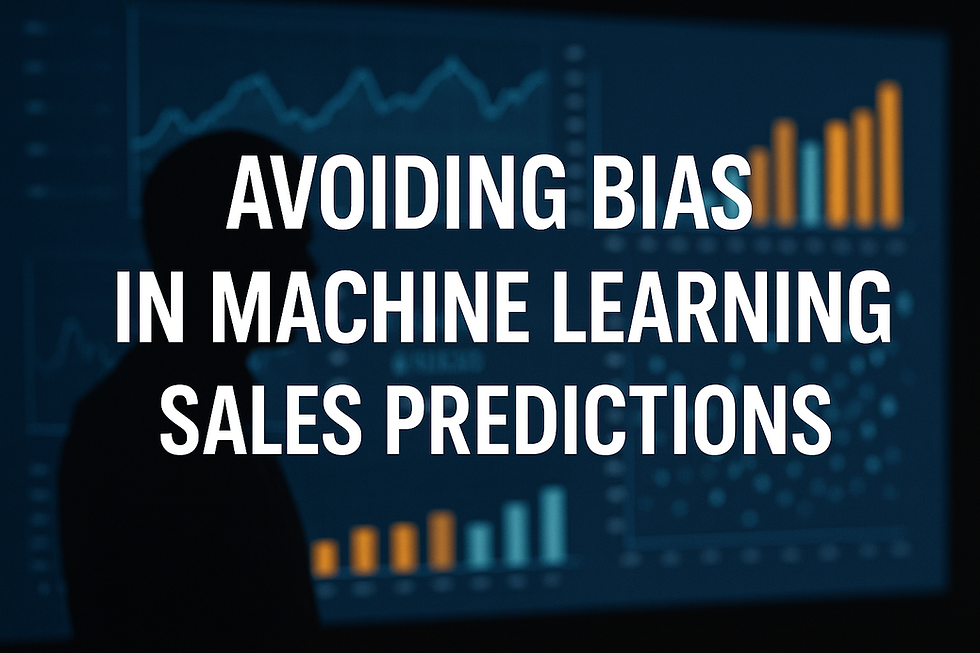Avoiding Bias in Machine Learning Sales Predictions
- Muiz As-Siddeeqi

- Aug 19
- 5 min read

Avoiding Bias in Machine Learning Sales Predictions
The Quiet Threat Lurking in Your AI Sales Models
It doesn’t scream. It doesn’t crash your system. It doesn’t even raise a red flag during your morning analytics check.
But it’s there.
Bias.
Creeping into your machine learning sales predictions silently. Twisting forecasts. Warping lead scores. Prioritizing some customers. Ignoring others. Sometimes costing you millions. Other times, hurting your brand in ways that no PR campaign can fix.
And here’s the worst part:
It often goes undetected. Until it’s too late.
That’s why avoiding bias in machine learning sales predictions isn’t just a technical best practice—it’s a critical mission. Because when your models start making unfair decisions at scale, the damage is no longer hidden. It becomes public, permanent, and painful.
So today, we're pulling the curtain back—fully. We're not going to sugarcoat, theorize, or pretend this is just a glitch. Bias in ML-based sales predictions is a real business, legal, and ethical risk. It’s also 100% preventable—but only if you know what you're dealing with.
Let’s dig into the real, raw, and researched reality of it all.
Bonus: Machine Learning in Sales: The Ultimate Guide to Transforming Revenue with Real-Time Intelligence
When Your Model Learns the Wrong Lessons
Machine learning doesn’t think. It learns. From your data.
And if your data reflects past discrimination, flawed assumptions, or incomplete records—guess what? That’s exactly what your model will learn, scale, and act on.
Amazon learned this the hard way.
In 2018, Reuters revealed that Amazon scrapped an internal AI recruitment tool because it penalized resumes that included the word “women’s”. The model had learned—based on historical hiring data—that male candidates were preferable.
Now replace “resumes” with “customer profiles” and “candidates” with “leads.”Can you see the risk?
Sales models trained on biased historical data will not just predict your future—they’ll replicate your past.
Real-World Sales Bias: The Cases That Actually Happened
Let’s get brutally real. Bias in sales predictions isn’t theoretical. It’s been caught in action—repeatedly:
1. Twitter Ads Platform Bias (2021)
In a study by Northeastern University and Mozilla, researchers found that Twitter’s ad recommendation system disproportionately favored men for ads related to high-paying job sectors, including tech and finance, even when gender wasn’t a targeting parameter 【Source: Mozilla Research, 2021】.
2. Facebook’s Algorithmic Targeting Controversy
The U.S. Department of Housing and Urban Development (HUD) sued Facebook in 2019, alleging that its algorithm allowed housing advertisers to exclude certain ethnicities and age groups from seeing property ads 【Source: HUD v. Facebook, 2019】.
This wasn’t just unethical—it violated federal laws like the Fair Housing Act.
3. Zip Code Discrimination in Insurance & Sales
Numerous insurance and financial services firms were found using ZIP code–based predictions that inadvertently discriminated against minority neighborhoods. These models often ended up reducing outreach and offers in those areas 【Source: Brookings Institution Report, 2021】.
These aren't outliers. These are warnings.
What Causes Bias in Machine Learning Sales Predictions?
Let’s break it down. Bias can creep in at multiple stages:
1. Biased Historical Sales Data
If your company historically favored enterprise buyers or didn’t target certain regions, your model might learn to do the same—thinking it's being "smart" when it's just being skewed.
2. Skewed Labeling
If “qualified leads” in your CRM were mostly white-collar urban clients, your model learns they are the definition of “good leads,” ignoring valid but different profiles.
3. Proxy Variables That Act as Disguised Bias
Zip codes, first names, even certain email domains (like Yahoo or Hotmail) can act as proxies for race, age, or socioeconomic class—introducing unintended discrimination.
4. Lack of Diverse Testing Data
When your test set doesn’t include diversity in buyer personas, demographics, industries, or behaviors, your model gets blind spots—and those blind spots show up in sales recommendations.
The Legal Heat Is Rising
Let’s get blunt: biased AI is not just bad business—it’s a legal minefield.
Europe’s GDPR
The General Data Protection Regulation (GDPR) explicitly requires “meaningful information about the logic involved” in automated decisions, especially when they significantly affect individuals (Article 22). Biased predictions? That’s a direct violation.
California’s CCPA & CPRA
These laws give consumers the right to know how automated systems make decisions and to opt out of profiling. If your model unknowingly discriminates—it’s no longer just unethical. It could be unlawful.
FTC Warning (2021)
The Federal Trade Commission issued a public warning: “Hold yourself accountable—or be ready for the FTC to do it for you.” That includes algorithmic discrimination.
How Bias Hurts Revenue (Not Just Ethics)
Some might still ask—what’s the ROI of avoiding bias?
Let’s show you.
A 2022 report by Forrester Consulting, commissioned by IBM, found that organizations that proactively mitigate bias in their AI workflows saw up to 30% better conversion rates in diverse customer segments【Source: IBM/Forrester, 2022】.
McKinsey’s 2023 AI in Sales study revealed that sales teams with de-biased lead scoring systems had 25% higher retention in multicultural markets.
A 2021 Harvard Business Review case analysis revealed that a financial tech company missed over $12 million in lifetime value by excluding underserved ZIP codes that were wrongly flagged as “low conversion risk.”
So if you think ethics and profit are separate—think again.
What Real Companies Are Doing to Fix It
Let’s talk solutions—with names.
Salesforce’s “AI Ethics by Design”
Salesforce formed a dedicated “Office of Ethical and Humane Use” in 2018. Since then, their sales products like Einstein have incorporated bias auditing features, including automatic alerts for discriminatory patterns in lead scoring 【Source: Salesforce Blog, 2023】.
LinkedIn’s Fairness Toolkit
LinkedIn developed a proprietary fairness toolkit called Fairness Flow, used to evaluate bias in model outcomes across race, gender, and region. It’s used in features like Who Viewed Your Profile and Lead Recommendations 【Source: LinkedIn Engineering, 2022】.
Accenture’s Responsible AI Framework
Accenture helps global sales teams deploy auditable, explainable, and fair ML models. Their framework is now used in over 100 enterprise sales departments worldwide—including insurance, pharma, and B2B tech 【Source: Accenture Responsible AI Casebook, 2022】.
How to Detect and Reduce Bias in Your Sales Predictions
This isn’t theory. This is your checklist.
1. Audit Your Training Data
Who’s included?
Who’s missing?
Are historical sales records reinforcing existing inequality?
Use tools like IBM AI Fairness 360, Microsoft Fairlearn.
2. Diversify Your Features
Avoid lazy proxies like:
Zip codes
Email domains
Inferred job titles
Instead, use behavior-based metrics:
Clickstream
Product views
Time-on-site
These are less likely to carry historical baggage.
3. Build Explainable Models
Use tools like:
SHAP (SHapley Additive exPlanations)
LIME (Local Interpretable Model-agnostic Explanations)
Explainable AI helps you see which features are influencing predictions—and whether those features are introducing bias.
4. Test Across Segments
Don’t just A/B test your top 10% of leads.
Run fairness checks across:
Gender
Age
Income brackets
Industry segments
Geography
Bias often hides in the corners.
5. Monitor in Real Time
Bias isn’t a one-time fix.
Use live dashboards to monitor disparities in sales model outcomes across customer groups.
Companies like H2O.ai, DataRobot, and Fiddler AI offer real-time bias detection tools.
Final Word: Sales AI Without Bias Is Just Smarter Sales
Let’s get honest—there’s no such thing as neutral data.
Your sales models are learning from the past. But the past wasn’t perfect. And unless you intervene, your machine learning systems will repeat those imperfections—at scale.
But here’s the good news:Bias is not inevitable. It's detectable. It’s preventable. And when you fix it, you don’t just do the right thing—you build smarter models, stronger teams, more loyal customers, and longer-lasting trust.
The sales AI of the future won’t just be fast, predictive, and automated.
It will also be fair, transparent, and inclusive.
That’s where real revenue—and real impact—live.

$50
Product Title
Product Details goes here with the simple product description and more information can be seen by clicking the see more button. Product Details goes here with the simple product description and more information can be seen by clicking the see more button

$50
Product Title
Product Details goes here with the simple product description and more information can be seen by clicking the see more button. Product Details goes here with the simple product description and more information can be seen by clicking the see more button.

$50
Product Title
Product Details goes here with the simple product description and more information can be seen by clicking the see more button. Product Details goes here with the simple product description and more information can be seen by clicking the see more button.






Comments